An Innovation Management Approach for Electric Vertical Take-Off and Landing
Abstract
1. Introduction
2. Status of Electric Vertical Take-Off and Landing
2.1. Introduction to the eVTOL
2.2. Classification of eVTOL
3. Technology Roadmapping
3.1. Introduction to Technology Roadmapping
3.2. Policy–Technology Roadmap
4. Main Layers of the Technology Roadmap
4.1. Technology
4.1.1. Status of Key eVTOL Technologies
Distributed Electric Propulsion Technology
Low Aerodynamic Noise Technology
Flight Control Technology
4.1.2. Future Prospects of eVTOL Key Technology Development
4.2. Product
4.3. Market
4.3.1. Target Users
4.3.2. Application Scenarios
4.3.3. eVTOL Operation
4.3.4. Further Market Segmentation Dimensional Analysis
4.4. Policy
- R&D Support: The government will allocate funds and establish research grants to facilitate advancements in eVTOL-related technologies, aiming to enhance safety and efficiency;
- Financial Support and Incentives: Tax breaks, subsidies, and loan guarantees will be provided to alleviate enterprise expenses, encouraging investment in eVTOL research, development, and manufacturing;
- Planning and Policy Guidance: Comprehensive industrial plans will be formulated to delineate goals for the eVTOL sector, fostering an environment conducive to investment and innovation;
- Market Access and Regulation: Stringent regulations and industry standards will be developed to ensure the quality and safety of eVTOL products, promoting standardization and instilling consumer confidence;
- Infrastructure Development: Significant investments will be made in eVTOL infrastructure, including charging stations and landing facilities, to bolster operational efficiency and facilitate the expansion of eVTOL transportation networks;
- Market Incentives: Subsidies and incentives will be offered to consumers to encourage the adoption of eVTOL technology, thereby accelerating market penetration and uptake.
5. The Construction of the Technology Roadmap
5.1. Policy Role Dimensions at Different Commercialization Stages
5.2. Technology–Product Dimensions at Different Commercialization Stages
5.3. Products at Different Stages of Commercialization—Market Dimension
6. Further Analysis of the TRM
6.1. Analysis by DEMATEL
6.1.1. Brief Introduction to DEMATEL
6.1.2. DEMATEL for Roadmap of eVTOL
| M11 | M12 | M13 | M21 | M22 | M23 | P1 | P2 | P3 | P4 | T1 | T2 | T3 | T4 | G1 | G2 | G3 | G4 | |
| M11 | 1 | 1 | 1 | |||||||||||||||
| M12 | 1 | 1 | ||||||||||||||||
| M13 | ||||||||||||||||||
| M21 | 1 | |||||||||||||||||
| M22 | 1 | |||||||||||||||||
| M23 | ||||||||||||||||||
| P1 | 1 | |||||||||||||||||
| P2 | 1 | 1 | 1 | |||||||||||||||
| P3 | 1 | 1 | 1 | |||||||||||||||
| P4 | 1 | 1 | ||||||||||||||||
| T1 | 1 | 1 | ||||||||||||||||
| T2 | 1 | 1 | 1 | |||||||||||||||
| T3 | 1 | 1 | 1 | |||||||||||||||
| T4 | 1 | |||||||||||||||||
| G1 | 1 | 1 | ||||||||||||||||
| G2 | 1 | 1 | ||||||||||||||||
| G3 | 1 | 1 | ||||||||||||||||
| G4 | 1 | 1 |
| M11 | M12 | M13 | M21 | M22 | M23 | P1 | P2 | P3 | P4 | T1 | T2 | T3 | T4 | G1 | G2 | G3 | G4 | |
| M11 | 0.444 | 0.235 | 0.444 | 0.235 | 0.333 | 0.259 | ||||||||||||
| M12 | 0.444 | 0.111 | 0.333 | |||||||||||||||
| M13 | ||||||||||||||||||
| M21 | 0.333 | 0.111 | ||||||||||||||||
| M22 | 0.333 | |||||||||||||||||
| M23 | ||||||||||||||||||
| P1 | 0.111 | 0.086 | 0.055 | 0.111 | 0.123 | 0.067 | 0.333 | 0.148 | 0.078 | |||||||||
| P2 | 0.333 | 0.259 | 0.165 | 0.333 | 0.370 | 0.202 | 0.444 | 0.235 | ||||||||||
| P3 | 0.333 | 0.259 | 0.333 | 0.259 | 0.444 | |||||||||||||
| P4 | 0.333 | 0.333 | ||||||||||||||||
| T1 | 0.148 | 0.165 | 0.128 | 0.148 | 0.214 | 0.144 | 0.444 | 0.346 | 0.219 | 0.333 | 0.111 | 0.037 | ||||||
| T2 | 0.111 | 0.235 | 0.219 | 0.111 | 0.272 | 0.232 | 0.333 | 0.593 | 0.424 | 0.333 | 0.111 | |||||||
| T3 | 0.111 | 0.235 | 0.111 | 0.235 | 0.333 | 0.593 | 0.333 | |||||||||||
| T4 | 0.111 | 0.111 | 0.333 | |||||||||||||||
| G1 | 0.086 | 0.133 | 0.116 | 0.086 | 0.162 | 0.125 | 0.259 | 0.313 | 0.214 | 0.333 | 0.444 | 0.148 | 0.049 | |||||
| G2 | 0.037 | 0.115 | 0.151 | 0.037 | 0.128 | 0.155 | 0.111 | 0.309 | 0.339 | 0.333 | 0.444 | 0.148 | ||||||
| G3 | 0.111 | 0.198 | 0.111 | 0.198 | 0.333 | 0.481 | ||||||||||||
| G4 | 0.333 | 0.444 | 0.148 |
6.2. Crossing the Chasm
7. Challenges in eVTOL Development and Commercialization
8. Conclusions
Author Contributions
Funding
Institutional Review Board Statement
Informed Consent Statement
Data Availability Statement
Acknowledgments
Conflicts of Interest
References
- Goyal, R.; Reiche, C.; Fernando, C.; Serrao, J.; Kimmel, S.; Cohen, A.; Shaheen, S. Urban Air Mobility (UAM) Market Study; 20190001472; National Aeronautics and Space Administration: Washington, DC, USA, 2018.
- Hideki, K. Development Trends and Prospects for eVTOL: A New Mode of Air Mobility; Global Strategic Studies Institute Monthly Report; Mitsui & Co.: Tokyo, Japan, 2018. [Google Scholar]
- Wei, D.; Na, S. Research on development status of eVTOL. Aeronaut. Sci. Technol. 2021, 32, 1–7. [Google Scholar] [CrossRef]
- EASA. Proposed Special Condition for Small-Category VTOL Aircraft; European Aviation Safety Agency: Brussels, Belgium, 2018; Volume SC-VTOL-01.
- Ugwueze, O.; Statheros, T.; Bromfield, M.A.; Horri, N. Trends in eVTOL aircraft development: The concepts, enablers and challenges. In Proceedings of the AIAA Scitech 2023 Forum, Reston, VA, USA, 23–27 January 2023; AIAA: Reston, VA, USA, 2023. [Google Scholar] [CrossRef]
- Deng, J.H. Technical status and development of electric vertical take-off and landing aircraft. Acta Aeronaut. Et Astronaut. Sin. 2024, 45, 529937. [Google Scholar]
- Wang, X. The Future of Urban Air Mobility Market Development. Aerosp. Power 2019, 4, 18–21. Available online: https://kns.cnki.net/kcms2/article/abstract?v=mjz80qGfPOXWapJAsY5ylA9PstP2yiehilg3vUsarXUPQqk6nCXrgYX6woouXZ8UDecB_8zcpEx82saY4iAj0Mf1AMWx8W0EAstyWE-xcRHDvn518zLES14e0wsKhNjoOm4Br8yb03U=&uniplatform=NZKPT&language=CHS (accessed on 30 April 2024).
- Garcia, M.L.; Bray, O.H. Fundamentals of Technology Roadmapping; Sandia National Laboratories: Albuquerque, NM, USA; Livermore, CA, USA, 1997. [Google Scholar] [CrossRef]
- Phaal, R.; Farrukh, C.J.; Probert, D.R. Technology roadmapping—A planning framework for evolution and revolution. Technol. Forecast. Soc. Change 2004, 71, 5–26. [Google Scholar] [CrossRef]
- Kostof, R.N.; Schaller, R.R. Science and technology roadmaps. IEEE Trans. Eng. Manag. 2001, 48, 132–143. [Google Scholar] [CrossRef]
- Phaal, R.; Farrukh, C.J.; Probert, D.R. Strategic roadmapping: A workshop-based approach for identifying and exploring strategic issues and opportunities. Eng. Manag. J. 2007, 19, 3–12. [Google Scholar] [CrossRef]
- Phaal, R.; Muller, G. An architectural framework for roadmapping: Towards visual strategy. Technol. Forecast. Soc. Change 2009, 76, 39–49. [Google Scholar] [CrossRef]
- Huang, C.; Xu, L.; Zhong, X.-T.; Su, J. A Framework of Integrated Policy-Technology Roadmap (P-TRM) and Its Use: Examples of Wind Turbine and Solar PV Industries. China Soft Sci. 2014, 5, 76–84. Available online: https://kns.cnki.net/kcms2/article/abstract?v=mjz80qGfPOWjAjMWliskn2afH5rNiBstflMScY1YZ_XPPswEEyYubMBhzt_ooGa85RGVCVekkBfI1kTFzKUvCplap7LmyNuELH0FtYZ3JYIwpmOGaOSSzIMyEGM-czvs&uniplatform=NZKPT&language=CHS (accessed on 30 April 2024).
- Hu, W.; Xia, B. A Framework of Policy-technology Roadmap of Disruptive Technology: A Case of New Energy Vehicle Industry in China. Sci. Technol. Prog. Policy 2024, 41, 25–34. Available online: https://kns.cnki.net/kcms2/article/abstract?v=mjz80qGfPOU_2e9EHapjNr97rVUgaLOpHL7A9do9OYQvru0JGlU2-F8lE_I2E9gRjGnk0779tfpF783asVNB8KXRBi61LVDcyL0qZN0ufDx5TNOKLlMY9Xs5FWH1RNbwdIStVR_DEko=&uniplatform=NZKPT&language=CHS (accessed on 30 April 2024).
- China Southern Airlines General Aviation Co., Ltd.; Shanghai Volant Aerospace Technology Co., Ltd. White Paper on Passenger eVTOL Applications and Markets; Shanghai, China, 2023; Available online: http://www.volantaerotech.com (accessed on 30 April 2024).
- Rogers, E. Diffusion of Innovations; Free Press: New York City, NY, USA, 1962. [Google Scholar]
- Moore, G.A. Crossing the Chasm, 3rd ed.; HarperCollins Publishers: New York, NY, USA, 2014. [Google Scholar]
- Han, Q.; Xi, Q.; Liu, H.; Zhang, B. Based on unmanned aerial vehicle (uav) control technology development trend of flight safety study. J. Mod. Electron. Technol. 2014, 37, 22–25. [Google Scholar] [CrossRef]
- Si, S.-L.; You, X.-Y.; Liu, H.-C. DEMATEL technique: A systematic review of the state-of-the-art literature on methodologies and applications. Math. Probl. Eng. 2018, 2018, 3696457. [Google Scholar] [CrossRef]
- Huang, C.-Y.; Shyu, J.Z.; Tzeng, G.-H. Reconfguring the innovation policy portfolios for Taiwan’s SIP mall industry. Technovation 2007, 27, 744–765. [Google Scholar] [CrossRef]
- Ren, J.; Manzardo, A.; Toniolo, S.; Scipioni, A. Sustainability of hydrogen supply chain. Part I: Identifcation of critical criteria and cause-efect analysis for enhancing the sustainability using DEMATEL. Int. J. Hydrogen Energy 2013, 38, 14159–14171. [Google Scholar] [CrossRef]
- Seyedhosseini, S.M.; Taleghani, A.E.; Bakhsha, A.; Partovi, S. Extracting leanness criteria by employing the concept of balanced scorecard. Expert Syst. Appl. 2011, 38, 10454–10461. [Google Scholar] [CrossRef]
- Alinezhad, A.; Khalili, J. DEMATEL method. In New Methods and Applications in Multiple Attribute Decision Making (MADM); Springer: Cham, Switzerland, 2019; pp. 103–108. [Google Scholar] [CrossRef]
- Hussaina, M.; Tapinosb, E.; Knighta, L. Scenario-driven roadmapping for technology foresight. Technol. Forecast. Soc. Change 2017, 124, 160–177. [Google Scholar] [CrossRef]
- de Weck, O.L. Technology Roadmapping and Development: A Quantitative Approach to the Management of Technology; Springer: Cham, Switzerland, 2022; pp. 215–222. [Google Scholar]
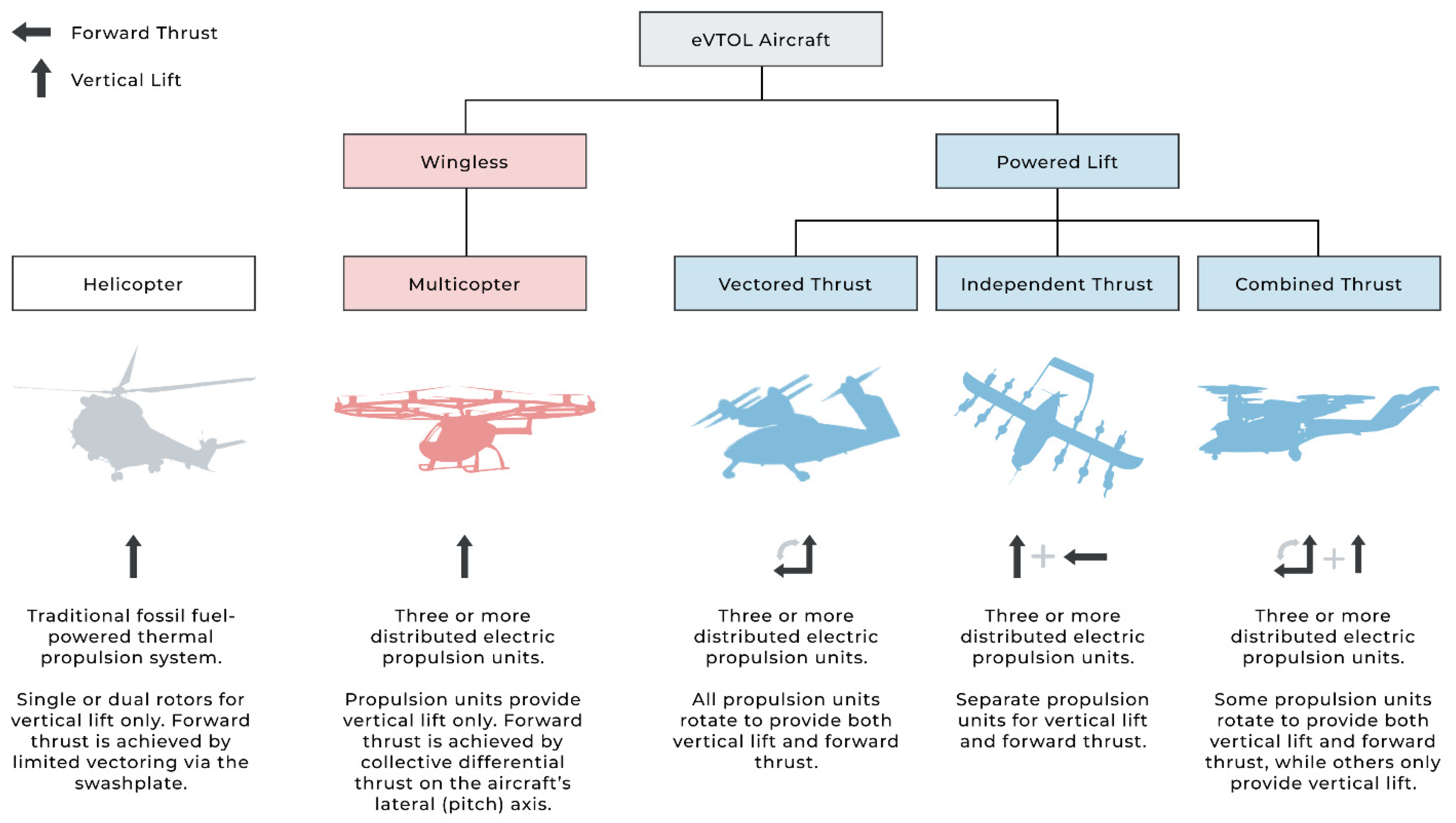
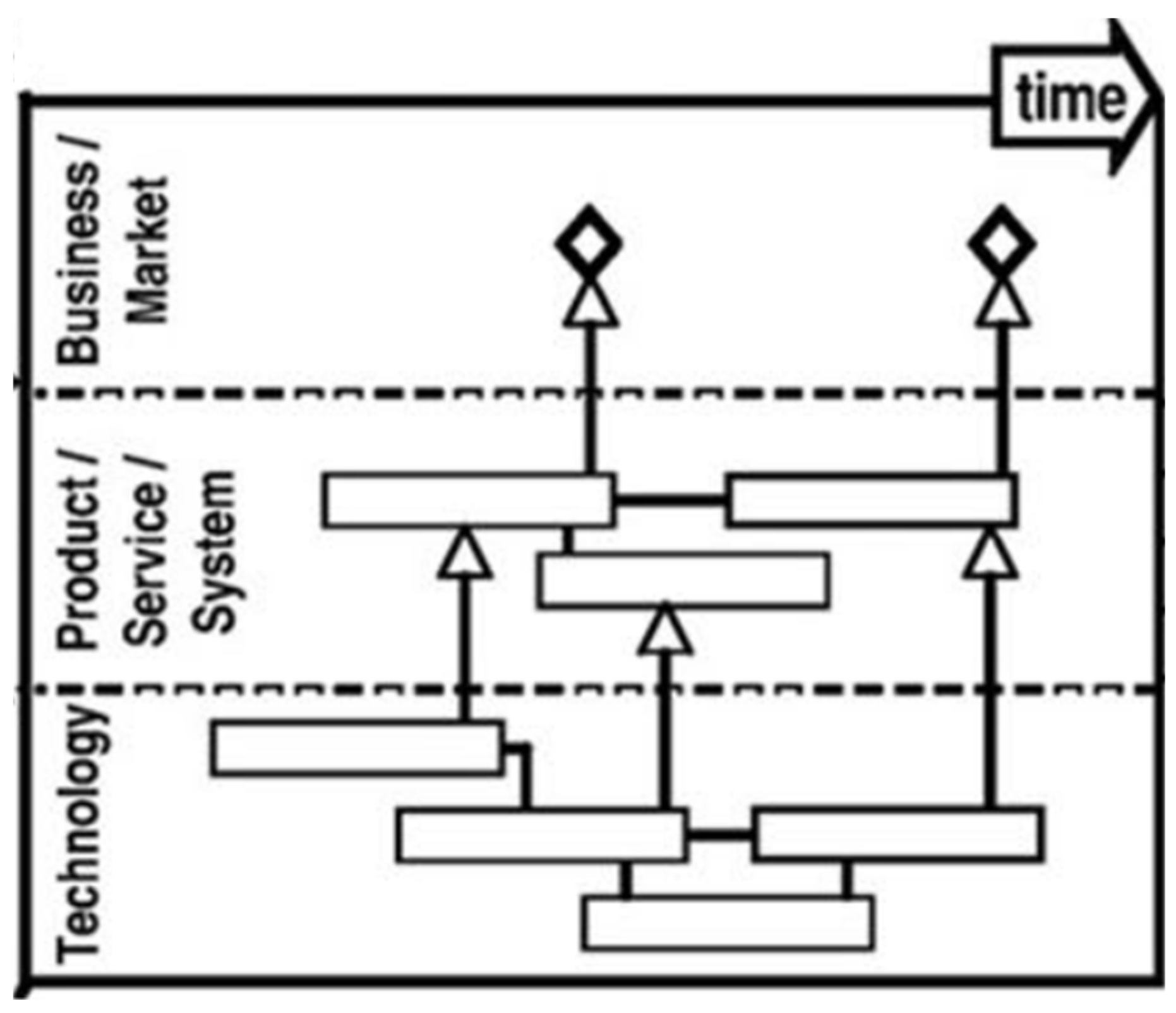
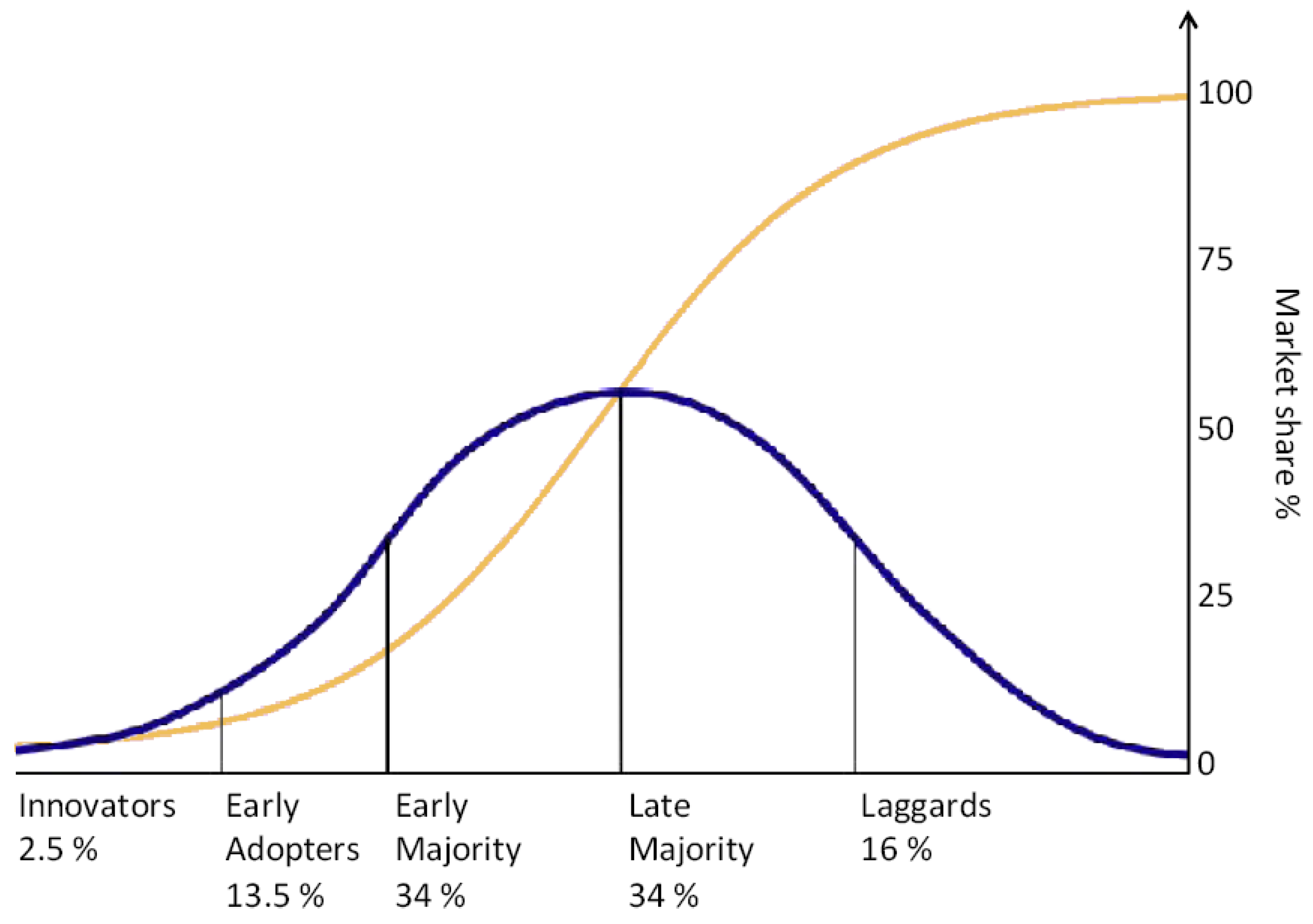

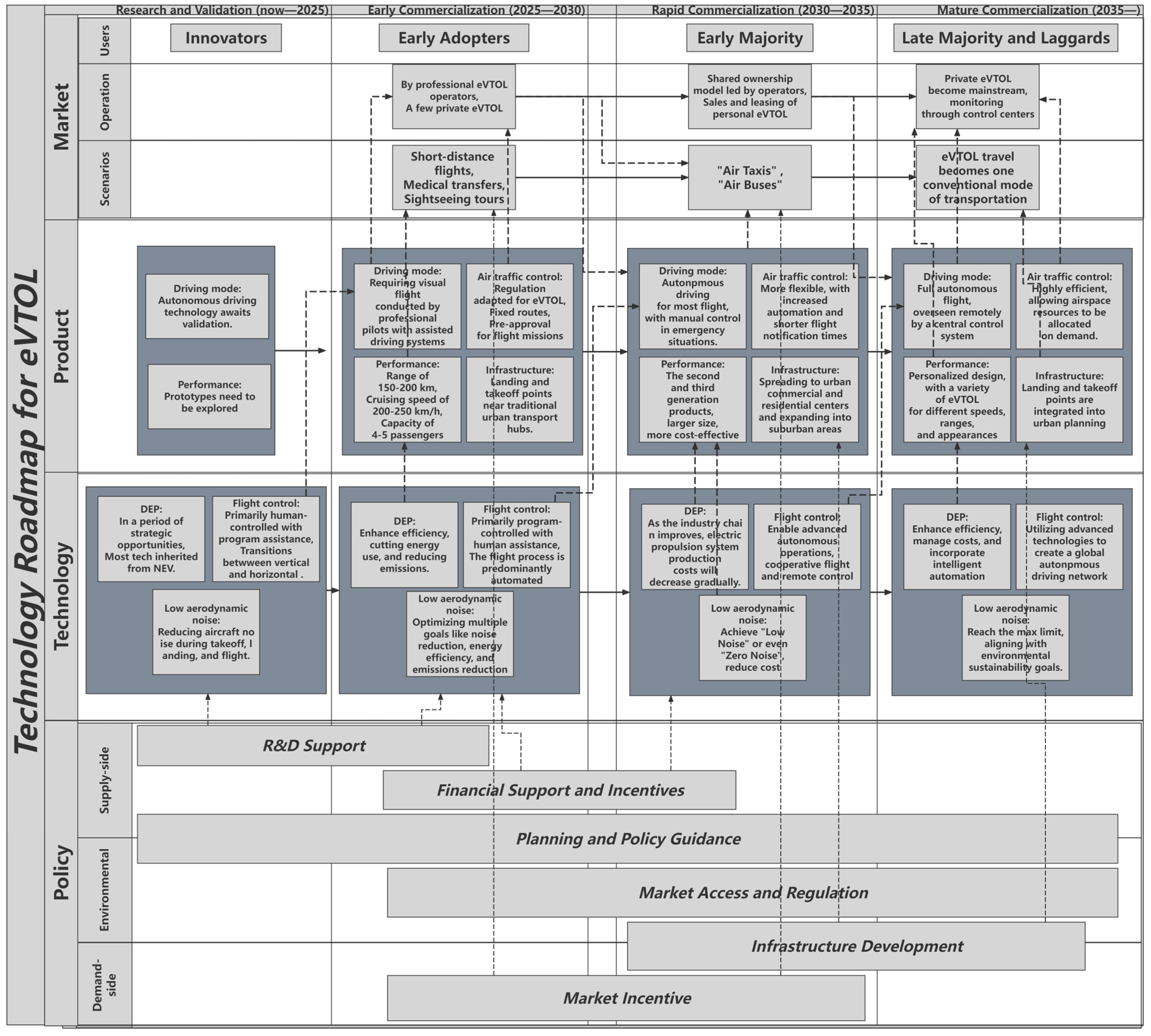
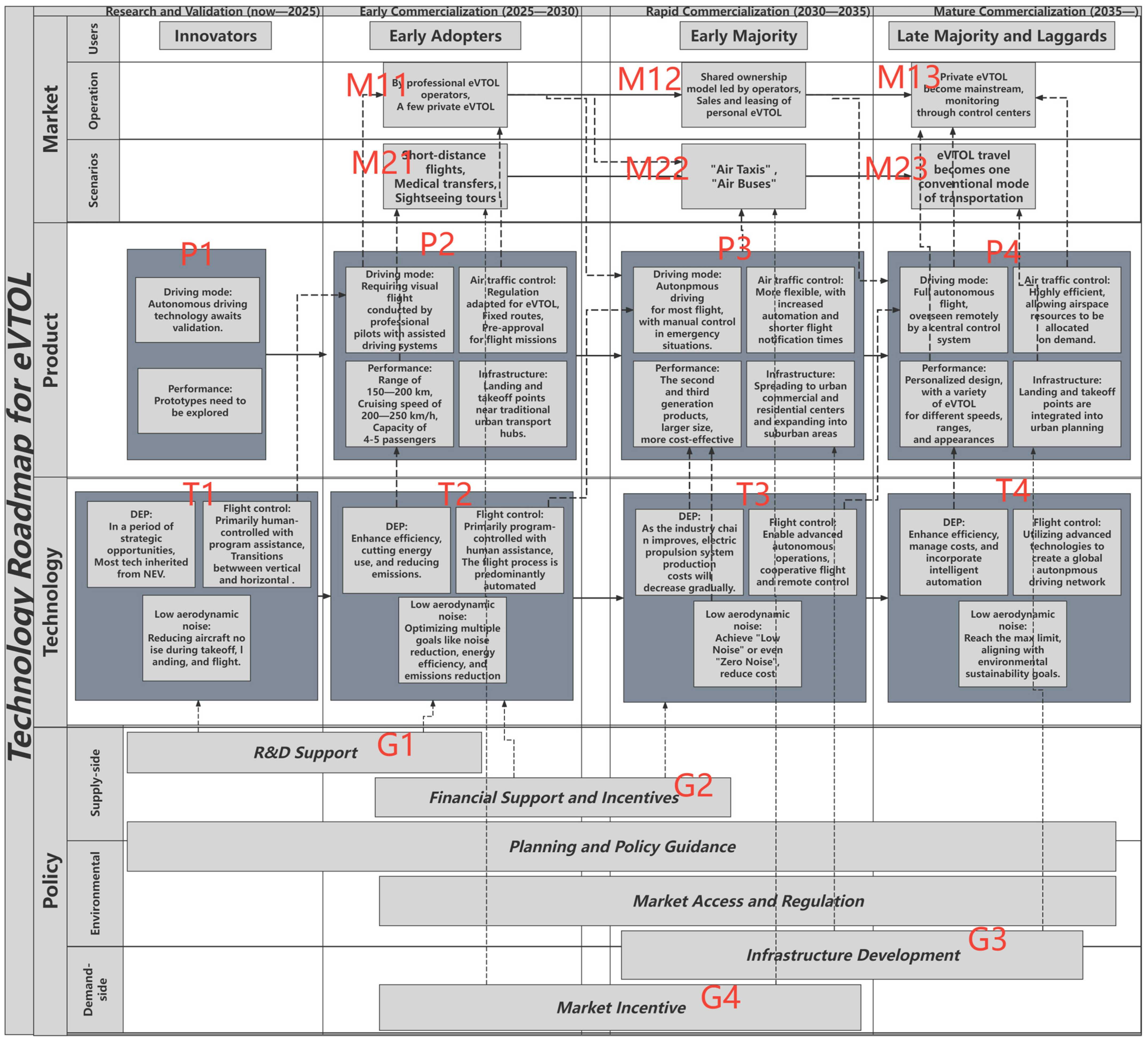
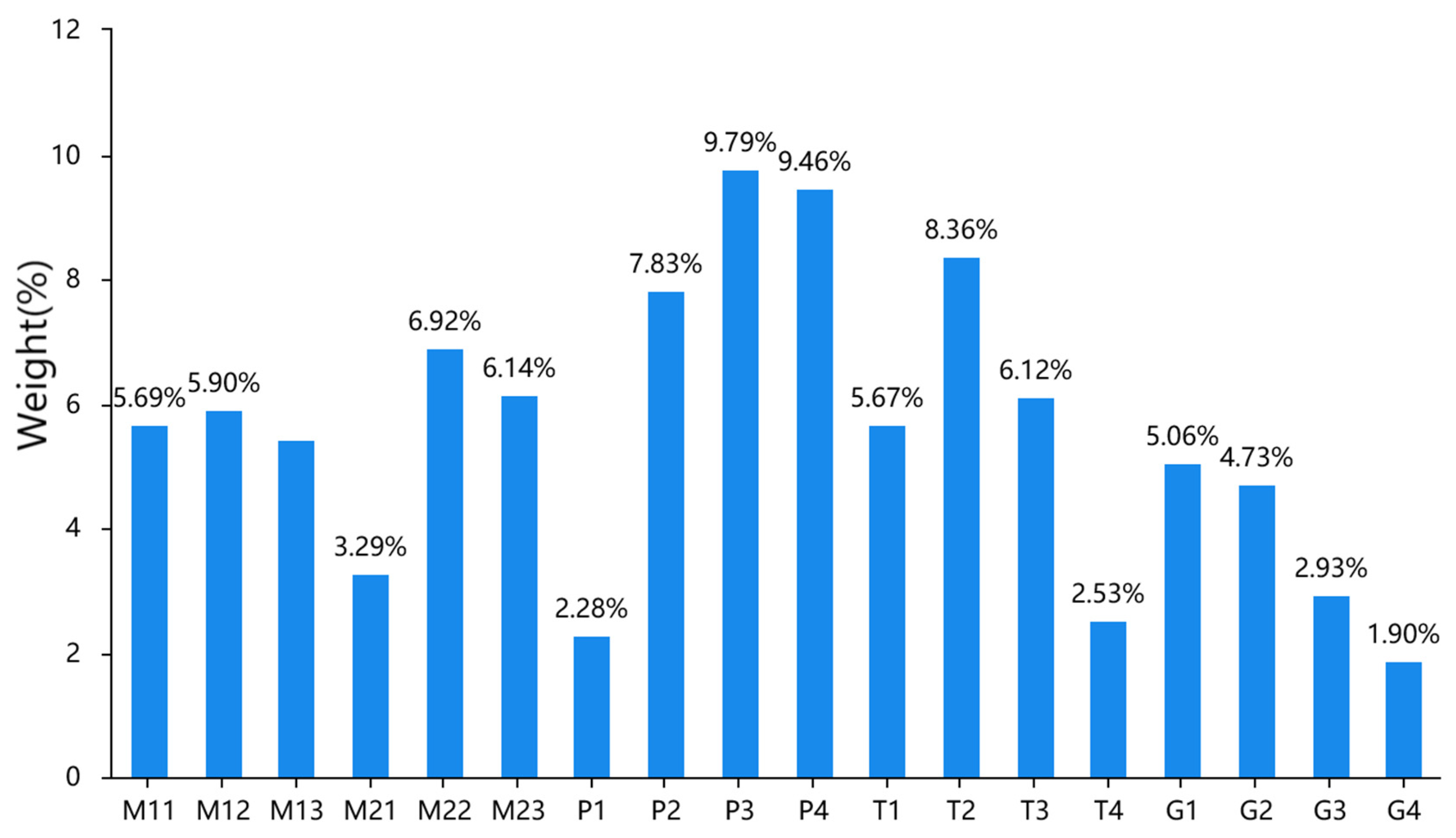
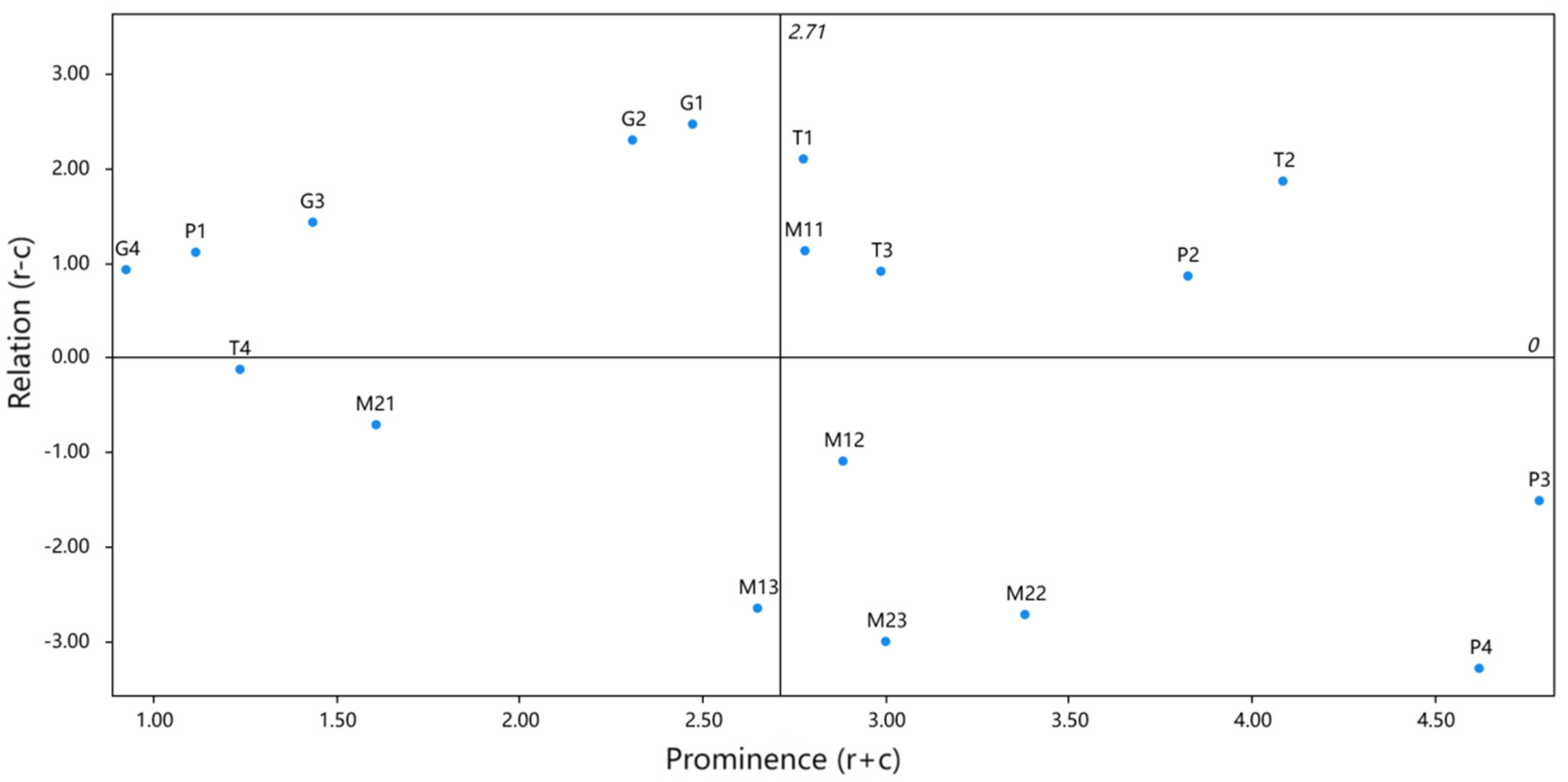

| Type of Policy Tools | Example | Effect |
|---|---|---|
| Demand-side policy | Public procurement, price subsidies | Stabilize the market environment for innovation, fostering confidence and stimulating technology research and development |
| Environmental policy | Standard design, goal planning | Environmental policy tools shape product design by imposing standardized requirements, fostering a competitive landscape that rewards innovation, and ultimately driving technological advancement and the emergence of new products |
| Supply-side policy | Technology infrastructure, technology input | Support enterprise research and development, encouraging investment and effective resource allocation |
| Research and Validation | Early Commercialization | Rapid Commercialization | Mature Commercialization | |
|---|---|---|---|---|
| Distributed Electric Propulsion | In a period of strategic opportunities, most tech inherited from NEV | Enhance efficiency, cutting energy use, and reducing emissions | As the industry chain improves, electric propulsion system production costs will decrease gradually | Enhance efficiency, manage costs, and incorporate intelligent automation |
| Low Aerodynamic Noise Technology | Reducing aircraft noise during take-off, landing, and flight | Optimizing multiple goals like noise reduction, energy efficiency, and emissions reduction | Achieve “Low Noise” or even “Zero Noise”, reduce cost | Reach the max limit, aligning with environmental sustainability goals |
| Flight Control Technology | Primarily human-controlled with program assistance | Primarily program-controlled with human assistance, the flight process is predominantly automated | Enable advanced autonomous operations, cooperative flight, and remote control | Utilizing advanced technologies to create a global autonomous driving network |
| Research and Validation Stage | Early Commercialization Stage | Rapid Commercialization Stage | Mature Commercialization Stage | |
|---|---|---|---|---|
| Driving mode | Autonomous driving technology awaits validation | Requiring visual flight conducted by professional pilots in collaboration with assisted driving systems | The system is responsible for most flight missions, equipped with professional pilots for manual control in emergency situations | Passenger eVTOL achieves full autonomous flight, overseen remotely by a central control system, removing the requirement for onsite professional pilots |
| Performance | Prototypes need to be explored through continuous experimentation and trial applications | The ideal performance parameters include a range of 150–200 km, a cruising speed of 200–250 km per hour, and a capacity of 4–5 passengers | The emergence of second- and third-generation commercial eVTOL products and the larger size of eVTOL | A trend towards personalized design, with a variety of eVTOLs designed and produced for different speeds, ranges, and appearances |
| Air traffic control | Initial studies and simulations are conducted to understand the impact of eVTOLs on existing air traffic systems; tests are performed to evaluate the effectiveness of proposed air traffic management solutions | Airspace and air traffic control systems have been adapted for low-altitude eVTOL flights, establishing fixed routes; pre-approval from relevant authorities is required for flight missions | Airspace management and air traffic control policies are becoming more flexible, with increased automation and shorter flight notification times | The air traffic management system will be highly efficient, allowing airspace resources to be allocated on demand |
| Infrastructure | Experimentation with various vertiport designs, materials, and layouts to ensure safety, efficiency, and minimal impact on existing urban environments | Landing and take-off points are set up near traditional urban transport hubs | Start spreading to urban commercial and residential centers and expanding into suburban areas | eVTOL landing and take-off points are integrated into urban planning |
| Stage | Consumer Groups | New Users | Characteristics |
|---|---|---|---|
| Research and Validation | Innovators | Technology pioneers, research institutions, aviation enthusiasts | -Interested in emerging technologies and new aircraft -Capable of investing significant resources into research and experimentation -Participate in research and testing processes |
| Early Commercialization | Early Adopters | Middle-income travelers, large corporations, affluent private users, individuals in need of air medical and tourism services | -Willing to try new products but more cautious compared to innovators -Often have substantial incomes |
| Rapid Commercialization | Early Majority | Ordinary consumers, urban residents, business travelers | -Majority of consumers -Wait for evidence of reliability and effectiveness -Willing to pay reasonable prices -Concerned about convenience and practicality |
| Mature Commercialization | Late Majority and Laggards | Suburban users, conservative individuals | -Cautious about new technologies |
| Effect Degree (r) | Cause Degree (c) | Prominence (r + c) | Relation (r − c) | Weight | |
|---|---|---|---|---|---|
| M11 | 1.951 | 0.827 | 2.778 | 1.123 | 0.057 |
| M12 | 0.889 | 1.993 | 2.882 | −1.104 | 0.059 |
| M13 | 0.000 | 2.649 | 2.649 | −2.649 | 0.054 |
| M21 | 0.444 | 1.160 | 1.605 | −0.716 | 0.033 |
| M22 | 0.333 | 3.047 | 3.380 | −2.713 | 0.069 |
| M23 | 0.000 | 3.000 | 3.000 | −3.000 | 0.061 |
| P1 | 1.114 | 0.000 | 1.114 | 1.114 | 0.023 |
| P2 | 2.342 | 1.481 | 3.823 | 0.860 | 0.078 |
| P3 | 1.630 | 3.152 | 4.782 | −1.523 | 0.098 |
| P4 | 0.667 | 3.954 | 4.620 | −3.287 | 0.095 |
| T1 | 2.439 | 0.333 | 2.772 | 2.105 | 0.057 |
| T2 | 2.974 | 1.111 | 4.085 | 1.863 | 0.084 |
| T3 | 1.951 | 1.037 | 2.988 | 0.914 | 0.061 |
| T4 | 0.556 | 0.679 | 1.235 | −0.123 | 0.025 |
| G1 | 2.471 | 0.000 | 2.471 | 2.471 | 0.051 |
| G2 | 2.308 | 0.000 | 2.308 | 2.308 | 0.047 |
| G3 | 1.432 | 0.000 | 1.432 | 1.432 | 0.029 |
| G4 | 0.926 | 0.000 | 0.926 | 0.926 | 0.019 |
| Aspect | Strategies |
|---|---|
| Technical Feasibility | Develop advanced electric flight technology, including high-energy-density batteries, efficient electric motors, and intelligent power management systems. Research and deploy infrastructure for flexible take-off and landing. Ensure sufficient flight range and passenger capacity. |
| Safety | Implement advanced automatic flight systems, including automatic take-off and landing, obstacle detection and avoidance, and flight path planning. Enhance emergency handling capabilities, such as automatic switching to backup power and emergency landing procedures. |
| Affordability | Reduce manufacturing and operating costs through improvements in materials, production processes, scale production, and supply chain management. Realize and apply fully automatic flight to minimize training and employment costs for professional pilots. Ensure price competitiveness to attract mainstream customers’ purchases. |
| Governmental Policies | Strategically direct policy support towards facilitating the crossing of the chasm. Overcome obstacles and streamline policy guidance and support for eVTOL to foster low-altitude economy development. |
| Environmental Impact | Develop and implement noise reduction technologies for eVTOL vehicles. Explore alternative energy sources for eVTOL propulsion to minimize carbon footprint. Conduct comprehensive environmental impact assessments throughout the eVTOL lifecycle. |
| Social Impact | Enhance public trust and acceptance through transparent communication and effective risk mitigation. Develop clear regulations and guidelines for safe eVTOL operation within urban environments. Invest in infrastructure development to ensure equitable access to eVTOL transportation for all citizens. |
Disclaimer/Publisher’s Note: The statements, opinions and data contained in all publications are solely those of the individual author(s) and contributor(s) and not of MDPI and/or the editor(s). MDPI and/or the editor(s) disclaim responsibility for any injury to people or property resulting from any ideas, methods, instructions or products referred to in the content. |
© 2024 by the authors. Licensee MDPI, Basel, Switzerland. This article is an open access article distributed under the terms and conditions of the Creative Commons Attribution (CC BY) license (https://creativecommons.org/licenses/by/4.0/).
Share and Cite
Li, T.; Xu, X.; Shen, L. An Innovation Management Approach for Electric Vertical Take-Off and Landing. Sustainability 2024, 16, 7135. https://doi.org/10.3390/su16167135
Li T, Xu X, Shen L. An Innovation Management Approach for Electric Vertical Take-Off and Landing. Sustainability. 2024; 16(16):7135. https://doi.org/10.3390/su16167135
Chicago/Turabian StyleLi, Tingyou, Xia Xu, and Luyi Shen. 2024. "An Innovation Management Approach for Electric Vertical Take-Off and Landing" Sustainability 16, no. 16: 7135. https://doi.org/10.3390/su16167135
APA StyleLi, T., Xu, X., & Shen, L. (2024). An Innovation Management Approach for Electric Vertical Take-Off and Landing. Sustainability, 16(16), 7135. https://doi.org/10.3390/su16167135






